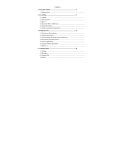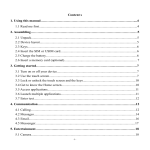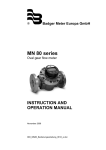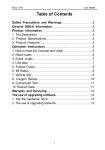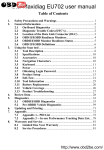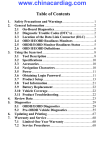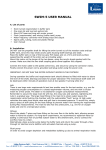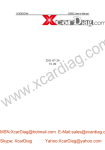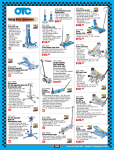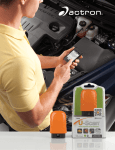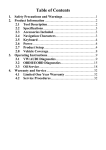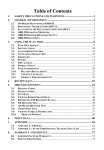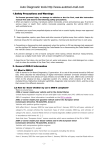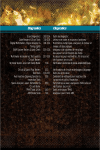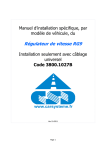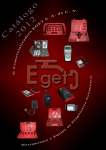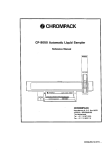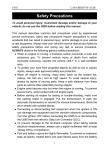Download obd manual by autoobdtools
Transcript
OBD Industry quick guide www.autoobdtools.com 1 OBD Industry quick guide www.autoobdtools.com Table of contents OBD History.......................................................................................................... 2 OBD-I................................................................................................................3 OBD-II.............................................................................................................. 3 EOBD................................................................................................................ 4 JOBD................................................................................................................. 4 OBD Protocol List................................................................................................. 5 OBD-II data link connector.............................................................................. 6 Pin Definition.................................................................................................. 7 The Location Of DLC.................................................................................... 8 DLC Equip Position....................................................................................... 8 Diagnostic Trouble Codes(DTC's)................................................................. 11 Mainly OBD Product In the Market.............................................................. 12 Auto code reader............................................................................................... 12 Mainly 7 Brand in the market................................................................. 12 Auto code reader common feature....................................................... 14 When you buy code reader,maybe you usually can see below terms in the product description........................................................... 15 How to use an Auto code reader........................................................... 15 Something you need note when buy a code reader....................... 16 The reason of trigger the check engine warning Light On.................. 17 2 OBD Industry quick guide www.autoobdtools.com OBD History OBD was first used by General Motors (GM) introduced in 1982. the purpose of obd is to monitor the emission control system. Once has a fault,OBD system lighten dashboard indicator light to inform the driver.At the same time build-in computer (often referred to as the engine control unit or module, that is, the ECU or ECM) in vehicle will record trouble code.This code can obtain by appropriate equipment in order to facilitate troubleshooting. General Motors(GM) uses an internal standard to achieve an external device to communicate with the electronic control unit.This communication standard was called Assembly Line Communications Link (ALCL),Later renamed the Assembly Line Diagnostics Link (ALDL).the Assembly Line Diagnostics Link (ALDL) protocol communicates at 160 baud with Pulse-width modulation (PWM) signaling and monitors very few vehicle systems.An upgraded version of the ALDL protocol appears which communicates at 8192 baud with half-duplex UART signaling. This protocol is defined in GM XDE-5024B. 3 OBD Industry quick guide www.autoobdtools.com OBD-I General Motors(GM) propose the concept get the California Air Resources Board (CARB) attention.In 1985, CARB adopted the standards developed by SAE and Require all vehicles sold in California must have some basic OBD functions from 1988. These requirements are generally referred to as "OBD-I". OBD-I can only control some parts and some of the emissions related to the circuit problem, the diagnosis is more limited.In addition, data communication protocol of get OBD information and connect an external device and the ECU interface is still not standardized. OBD-II OBD-II is an improvement over OBD-I in both capability and standardization. The OBD-II standard specifies the type of diagnostic connector and its pinout, the electrical signalling protocols available, and the messaging format. It also provides a candidate list of vehicle parameters to monitor along with how to encode the data for each. There is a pin in the connector that provides power for the scan tool from the vehicle battery, which eliminates the need to connect a scan tool to a power source separately. However, some technicians might still connect the scan tool to an auxiliary power source to protect data in the unusual event that a vehicle experiences a loss of electrical power due to a malfunction. Finally, the OBD-II standard provides an extensible list of DTCs. As a result of this standardization, a single device can query the on-board computer(s) in any vehicle. This OBD-II came in two models OBD-IIA and OBD-IIB. OBD-II standardization was prompted by emissions requirements, and though only emission-related codes and data are required to be transmitted through it, most manufacturers have made the OBD-II Data Link Connector the only one in the vehicle through which all systems are diagnosed and programmed. OBD-II Diagnostic Trouble Codes are 4-digit, preceded by a letter; P for engine and t r a n s m i s s i o n , B f o r B o d y, C f o r C h a s s i s a n d U f o r N e t w o r k . 4 OBD Industry quick guide www.autoobdtools.com EOBD EOBD is a version of OBD-II required in Europe since Model Year 2003 for diesel vehicles and since 2001 for gasoline vehicles. With Euro V and Euro VI emission standards, EOBD emission thresholds will be lower than previous Euro III and IV. EOBD refers to Europe On-Board Diagnostics. JOBD JOBD is a version of OBD-II for vehicles sold in Japan. OBD-II,EOBD,JOBD content above from wiki: http://en.wikipedia.org/wiki/On-board_diagnostics 5 OBD Industry quick guide www.autoobdtools.com OBD Protocol List An OBD2 compliant vehicle can use any of the five communication protocols: PWM (Pulse Width Modulated) SAE/J1850 SAE-established OBD II communication standard used by Ford domestic cars and light trucks. One of three hardware layers defined by OBD II. VPW(Variable Pulse Width Modulated) SAE/J1850 SAE-established OBD II communication standard used by GM cars and light trucks. One of three hardware layers defined by OBD II. K-Line ISO/9141-2 1994/Amd.1: 1996, Road vehicles — Diagnostic systems — Part 2: CARB requirements for interchange of digital information — Amendment 1 ISO/14230-4 (KWP2000) This is a newer version of the ISO9141 protocol. It has a provision for a fast initialization which may be used instead of the slow 5bps handshake sequence. CAN (Controller Area Network) ISO/15765, SAE/J2480 CAN is becoming the most widely used bus for in-vehicle communications. It is a high speed/high performance protocol. 6 OBD Industry quick guide www.autoobdtools.com Other non-OBD2 protocols LIN (Local Interconnect Network) LIN is a low cost, low speed, in-vehicle network intended to complement the higher performance CAN network. Vehicle systems with modest network requirements are placed on a LIN sub-network to reduce costs. The LIN sub-networks connect to the vehicle’s CAN network via gateways. LIN uses a single-wire enhanced ISO9141 implementation (non-OBDII protocol). UBP (UART Based Protocol) UBP is a Ford defined protocol. CCD CCD is a Chrysler defined protocol. ALDL (ALDL Assembly Line Diagnostic Link) ALDL is GM defined protocol. OBD-II data link connector Since 1996, the data link connector (DLC) is a standardized 16 cavity connector shown below.Connector design and location is dictated by an industry wide standard. Vehicle manufacturers can use the empty DLC cavities for whatever they would like.however,the DLC of every vehicle is required to provide pins 4 and 5 and 16 as defined below. When the Controller Area Network (CAN) protocol is fully implemented in the 2008 model year, all vehicles must use pins 6 and 14 as defined below. 7 OBD Industry quick guide www.autoobdtools.com Pin Definition Terminal 2 - SAE J1850 10.4k bits per second (BPS) variable pulse width serial data (GM Class2) or SAE J1850 41.6k bps pulse width modulation serial data high line (Ford). Terminal 4 - Scan tool chassis ground. Terminal 5 - Common signal ground for serial data lines (Logic Low). Terminal 6 - ISO 11898/15765/SAE J2284 CAN serial data high line. Terminal 7 - ISO 9141 K serial data Line or ISO 14230 (Keyword 2000) serial data line (DaimlerChrysler/Honda/Toyota) Terminal 10 - SAE J1850 41.6k bps pulse width modulation serial data low line (Ford). Terminal 14 - ISO 11898/15765/SAE J2284 CAN serial data low line. Terminal 15 - ISO 9141 L serial data Line or ISO 14230 (Keyword 2000) serial data line (DaimlerChrysler/Honda) Terminal 16 - Scan tool power (Unswitched battery positive voltage) 8 OBD Industry quick guide www.autoobdtools.com The Location Of DLC The DLC(Data Link Connector or Diagnostic Link Connector) is the standardized 16-cavity connector where diagnostic scan tools interface with the vehicle’s on-board computer.the DLC is usually located 12 inches from the center of the instrument panel (dash),under or around the driver’s side for most vehicles.if you can't find it,you can refer owner Manual or search on google. DLC Equip Position SAE J1962 do the following functional requirements to the position of the DLC Consistency of Location - The vehicle connector shall be located in the passenger compartment in the area bounded by the driver’s end of the instrument panel to 300mm beyond the vehicle centerline, attached to the instrument panel, and accessible from the driver’s seat. The preferred location is between the steering column and the vehicle centerline. The vehicle connector shall be mounted to facilitate mating and unmating. Ease of Access - Access to the vehicle connector shall not require a tool for the removal of an instrument panel cover, connector cover, or any barriers. The vehicle connector should be fastened and located as to permit a one-handed/blind insertion of the mating test equipment connector. Visibility - The vehicle connector should be out of the occupant’s (front and rear seat) normal line of sight but easily visible to a “crouched” technician.” — SAE J1962 “Diagnostic Connector” (June 1992) Just take the following fig. as a showing example 9 OBD Industry quick guide www.autoobdtools.com Picture from EPA VPCD-98–14: On-Board Diagnostic Guidance - Diagnostic Link Connector Location and Accessibility For Example: Audi A4 MY1998 10 OBD Industry quick guide www.autoobdtools.com The Location of Data Link Connector 11 OBD Industry quick guide www.autoobdtools.com Diagnostic Trouble Codes(DTC's) EOBD/OBD II Diagnostic Trouble Codes are codes that are stored by the on-board computer diagnostic system in response to a problem found in the vehicle. These codes identify a particular problem area and are intended to provide you with a guide as to where a fault might be occurring within a vehicle. OBD II/EOBD Diagnostic Trouble Codes consist of a five-digit alphanumeric code. The first character, a letter, identifies which control system sets the code. The other four characters, all numbers, provide additional information on where the DTC originated and the operating conditions that caused it to set. Here below is an example to illustrate the structure of the digits: 12 OBD Industry quick guide www.autoobdtools.com Mainly OBD Product In the Market You usually can see below products in the market Airbag reset tool Auto code reader Auto ECU programmer Auto Key Programmer(auto locksmith tool) Chip Tuning Tool Mileage Correction Tool Diagnostic Software Professional Diagnostic Heavy Duty Diagnostic Other OBD2 Vehicle Tools In this document,I mainly want to introduce auto code reader,because it can be used for all the pepole who own a car.if you want to buy other OBD products,pls visit our offical website:http://www.autoobdtools.com you can get help by live support for online chat with our Customer Service on business time.or you can call 0086 755 28186070. Also you can send a email to [email protected] Auto code reader Auto Code reader are also called auto code scanners, automotive diagnostic code readers, and OBD II Code Readers. They are handheld devices that connect to your car’s on board diagnostic system and read its information. They have other diagnostic features including the ability to reset or turn off the Check Engine Light or other fault lights. Mainly 7 Brand in the market Autel 1. 1.Autel Website:http://www.auteltech.com/ autel is a chinese company mainly produce automotive diagnostic tools,such as Code Readers,Scan Tools,Oil Reset Tool.etc. Mianly Product Model: MaxiScan Code Readers MaxiScan® MS300 MaxiScan® MS309 MaxiScan Scan Tools 13 OBD Industry quick guide www.autoobdtools.com MaxiScan® MS310 MaxiScan® MS409 MaxiScan® VAG405 MaxiScan® MS509 MaxiScan® MS609 MaxiDiag® JP701 MaxiDiag® EU702 MaxiDiag® US703 MaxiDiag® FR704 MaxiDiag PRO MD801 ABS/Airbag Scanner AA101 Launch 2. 2.Launch Website:http://www.cnlaunch.com Launch Tech Co Ltd was founded in 1993 and is the first professional high-tech company of in China for developing, producing and selling manufacture that providing a full range of Auto Diagnosis, Auto Testing, Auto Cleaning equipment and service solutions for workshops. Launch was listed on the Hong Kong stock market in 2002 (HK STOCK CODE: 8196) and is one of the first Domestic enterprises which successfully financed in Hong Kong. Mianly Product Model: Scan tool X-431 Diagun X-431 Heavy-Duty X-431 Master X-431 Tool AutoBook DIY Scan Tool Creader VI Creader IV FOR OBDII&EOBD OBDBook 6830 CReader V CRecorder for OBDII Actron 3. 3.Actron Website:http://www.actron.com/ actron is an american company mainly produce Scan tools, code scanners, code readers, automotive diagnostics, automotive batteries, battery management etc. Mianly Product Model: actron Scan Tools AutoScanner CP9575 Elite AutoScanner® Pro CP9190 Elite AutoScanner® CP9185 AutoScanner Plus CP9580 14 OBD Industry quick guide www.autoobdtools.com actron Code Readers PocketScan Code Reader CP9125 PocketScan Plus CP9550C actron Code Scanners Ford Code Scanner CP9015 GM Code Scanner CP9001 Equus Innova 4. 4.Equus Website:http://www.equus.com/ Equus has manufacturing facilities located in Taiwan,China and the United States. Sales, service and warehousing facilities for North America are located in Fountain Valley, California and Vancouver, British Columbia. All products distributed in North America are researched, developed and designed at the California facility. Mianly Product Model: Obd2 diagnostic tool 3020 CanOBD2® Tool 3030 CanOBD2® Car Reader™ 3040 OBD2 ScanTool™ 3100 CanOBD2® Diagnostic Tool™ 3120 CanOBD 2&1 Tool Kit™ 3130 Scan Tool – CanOBD2® 3140 Scan Tool CanOBD2&1® Kit 3150 ABS + CanOBD2® Diagnostic Tool 3160 ABS + CanOBD2® Scan Tool Roadi 5. 5.Roadi Website:http://www.roadico.com/about.php AutoXray 6. 6.AutoXray Website:http://www.autoxray.com OTC 7. 7.OTC Website:http://www.otctools.com/ Auto code reader common feature � Can Work 1996 & later OBD2/CAN compliant US, European and Asian vehicles. � Easily determines the cause of the “Check Engine Light”. � Turns off Check Engine Light (MIL), clears codes & resets monitors. � Displays DTC definitions on screen. � Views freeze frame data. � Backlit display � CAN compliant have the ability to read a vehicle’s Vehicle Identification Number. � Views freeze frame data 15 OBD Industry quick guide � � � www.autoobdtools.com Manufacturer Specific Codes Come with Molded Storage Case Some models have the capability of updating their internal software When you buy code reader,maybe you usually can see below terms in the product description: Abbreviations Abbreviations:: ABS – Anti-lock Brake System CAN – Controller Access Network – a standard for connecting electronic control units (ECUs) DTC – Diagnostic Trouble Code – The numerical error code retrieved from the vehicle’s computer DTC Definitions – Diagnostic Trouble Code definitions – What the numerical error codes actually mean MIL – Malfunction Indicator Lamp OBD – On Board Diagnostics OBD II – On Board Diagnostics II, the standard for 1996 and newer cars P0, P2, P3, U0 Codes – These are generic codes common to all OBD II cars P1, P3, and U1 – These are manufacturer specific codes VIN – Vehicle Identification Number How to use an Auto code reader 1.find the location of diagnostic link connector (DLC),if can't find it,pls refer your owner manual or search on google for result. 2.Remove the DLC cover if there is one. 3.Insert the code reader's plug into the DLC outlet. This outlet is easily identified, since it is similar in shape to the code reader's plug. 4.Turn the ignition key to the "on" position without starting the engine. This will provide power to all electrical components and illuminate the instrument panel lights. 5.Read the menu of the code reader and use the key or arrow to move to the "read codes" or "DTCs" (diagnostic trouble codes) option. If someting you don't know, you will need to read the manual of the code reader to fully understand all of its functions. 6.Press the "enter" key, if applicable, once the "read codes" or "DTCs" option has been selected. Refer to the code reader manual to determine which DTC triggered the malfunction indicator lamp (MI, also known as the check engine light or service engine light). 16 OBD Industry quick guide www.autoobdtools.com Something you need note when buy a code reader did this code reader cover your vehicle? 1. 1.did when you view the code reader,the first thing you should consider is “Will it work on my vehicle?”.Although it’s true that OBDII system is a standard, there are five different types of hardware communications used by OBDII vehicles. Some tools support all five and some are manufacturer specific.so you should check.if you can’t see whether it support your car in product description.you should ask the deal or buy from another that have clearly instruction. 2.function support if a code reader support many and complicated function.it ‘ll more useful to diagnostic cars.but as a junior DIYER, we usually need a general code reader,advance scan tool not suit for newbie,it designed for car repair shop or advance DIYER.so when you choose,you just need take under $100 buy a code reader that enough for you.after you improve your level,you can buy a advance scan tool,professional diagnostic tools,ecu programmer and etc. 3.does it support upgrade? every year vehicle manufacturers may release new models and revise existing models. so if you want your scan tool to fully support the new vehicles, it must be updated. Professional quality scan tools are updateable. 4.come with a user manual? For anyone working on his or her own vehicle, the Factory Service Manual or owner manual is a must-have. But the scantool itself may be able to provide some of that necessary information. When a trouble code is set, does the tool display the DTC number or give the full definition? A tool that displays the full definition will save a lot of time and frustration. Does the tool offer any information on typical readings to explain what the reading is?if don’t, you can lookup on the category “OBD-II dtc codes lookup” of our blog,search obd trouble codes,obd dtc codes.obd trouble codes for your vehicle’s model,brand or on the obd-codes.com to get info. 5.can save diagnostic datas? when park your car in a ditch to try and watch a code reader display while doing a roadtest. A tool that saves data can allow safe viewing back at the garage. it is a must function. Be certain that the tool you buy has this capability. 17 OBD Industry quick guide www.autoobdtools.com The reason of trigger the check engine warning Light On The Check Engine light of your vehicle is designed to turn on when certain sensors aren't functioning properly, a valve is loose, or your car's about to explode (just kidding about the last one). It can be difficult to figure out what the Check Engine light is trying to tell you to, but there are a few things you can check yourself. The oxygen sensor is probably the most common cause of a ‘check engine engine’’ warning. However, it can be a gradual deterioration of the sensor and the driver may not notice the resulting reduction in overall engine performance. Maintenance schedules generally recommend an inspection or replacement every 50,000 to 80,000 kilometres if it’s an “unheated” 1 or 2-wire sensor or every 100,000 to 160,000 kilometres if it’s a “heated” 3 or 4 wire (OBD2) sensor. A degraded oxygen sensor can increase fuel consumption by 10 to 15 percent. Definitely not what you want when fuel prices are as high as they are. Other signs that the oxygen sensor is worn out include excessive exhaust emissions, engine surging or hesitation, even premature failure of the catalytic converter. Other problems may trigger the engine warning light to come include: • a failed sensor such as oxygen, coolant temperature, MAP (manifold absolute pressure) or airflow meter. • engine problems such as poor performance, faulty spark plugs and wires, or clogged fuel injectors. • emissions problems such as a loose or cracked vacuum hose, loose or missing gas cap, or a failed EGR (exhaust gas recirculation) valve. • electrical wiring that has a short or open circuit. 18 OBD Industry quick guide www.autoobdtools.com How you should react to the warning light depends on how the light behaves: • If the light comes on for a little while and then goes out, you may have a momentary problem in the system. Once the light goes out, the problem is no longer occurring but it may have caused the computer to store a diagnostic trouble code in its memory. This isn’t cause for immediate action, however, you should take the vehicle in as soon as you can and have it looked at. • If the light comes on and stays on, it indicates an ongoing problem. It may not be a major problem however it may affect your car’s performance, gas mileage and emission levels. Definitely take your vehicle to a repair shop as soon as possible. • If the light flashes on and off, the vehicle has a severe problem that will cause additional damage. If your repair shop is nearby, take the car in immediately. If not, shut off the car and call for assistance. Your car’s user manual is the best source of information on maintaining your car’s performance and dashboard warning lights. 19



















